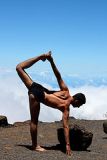Flexibility Exercises
 What is flexibility? – The entire skeletal system is held together with ligaments which hold one bone to the other. Muscles on the other hand are connected to the bones through tendons. How pliable and in shape these tissues are – is what flexibility is all about. Flexibility aids a person in everything – sitting, walking, jogging, sports, housework etc. It is important therefore to include a regimen to promote flexibility in your workouts. There can be many ways. You may take up Yoga or Pilates, or if you are already a sportsperson, include them in your schedule. Or if you follow a regular physical exercise routine, devote – say fifteen odd minutes after every workout towards stretching and exercises that increase flexibility – it would also aid in the gradual cooling down of the body.
What is flexibility? – The entire skeletal system is held together with ligaments which hold one bone to the other. Muscles on the other hand are connected to the bones through tendons. How pliable and in shape these tissues are – is what flexibility is all about. Flexibility aids a person in everything – sitting, walking, jogging, sports, housework etc. It is important therefore to include a regimen to promote flexibility in your workouts. There can be many ways. You may take up Yoga or Pilates, or if you are already a sportsperson, include them in your schedule. Or if you follow a regular physical exercise routine, devote – say fifteen odd minutes after every workout towards stretching and exercises that increase flexibility – it would also aid in the gradual cooling down of the body.
Flexibility Guidelines:
Avoid jerky and bouncing motions: When working on their flexibility, people often force their body way past their personal natural limits by bouncing or jerking their limbs. Flexibility is about the pliability and the ability of the muscles and ligaments to stretch. The bouncing and jerking has the opposite effect, since the muscles and ligaments contract to counter the forced motion. What works, is to slowly stretch the concerned body part till short of the point of pain, and hold it there for a while. It takes a while before your ligaments start getting pliable, especially so if you start working on flexibility late in life. Increasing flexibility is a slow and steady business.
Flexibility needs warm up too: When doing a workout purely to improve upon your flexibility, it is important to warm up, especially so in winters. If the joints and the tissues are warmed up, the body stretches and flexes much better. As is the case with warming up, the ligaments are less likely to get pulled or fatigued. If you attend or have attended yoga classes, and the instructor is good, the yoga regimen would already have a warm out built in into the sequence. If you are doing callisthenic stretching, a light jog, or skipping, or some free hand squats can be done to warm up the joints first. A light sweat when built up can be considered as an indicator that the body is adequately warmed up.
Use it on the “difficult days”: There is many an occasion when you do not feel like going out for a jog or hitting the gym or engaging in any kind of intense activity. You could use such days to catch up on some stretching and breathing exercises. If you warm up to it, you can do a full yoga routine. You end up feeling better, and check it out for yourself – you might find yourself doing much better in your next run or workout.